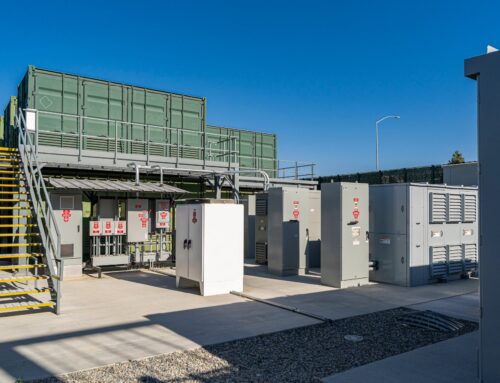Clean energy is big business. These 5 threats loom large.
April 22, 2025
According to the American Clean Power Association, 93 percent of the new energy capacity added to the US power grid in 2024 — 49 gigawatts — came from low greenhouse gas emissions sources like wind, solar, and batteries. And the trends show no sign of stopping: the Energy Information Administration projects that just solar and battery power together will account for 81 percent of the new capacity added to the grid in 2025.
It’s not just the US; about 80 percent of the global increase in electricity generation in 2024 came from zero emissions sources like renewables and nuclear, even in developing countries and places that don’t have strong climate goals in place. Last year, Pakistan purchased 22 gigawatts of solar panels, almost half of what the US installed.
Countries, states, grid operators, and private companies aren’t exactly making these decisions out of a benevolent desire to save the Earth. They’re doing it because it’s often the fastest, most affordable route to more energy.
“These people were not climate fanatics or folks who are solving for climate change; they were solving for human needs in their homes,” said Jigar Shah, who led the US Department of Energy’s Loan Programs Office under President Joe Biden — which by the end of 2024 had issued $69 billion in financing for clean energy projects. “Clean energy is the dominant way by which you actually add electricity to the grid today.”
But there are political, market, and technological forces that could slow this shift down drastically. We’re getting a picture of that in real time as President Donald Trump’s tariffs send the global economy on a roller coaster ride. The twists and turns are especially stomach-churning for clean energy. The supply chains for photovoltaic panels, wind turbines, and lithium-ion cells stretch around the world. Tariffs will raise costs for the raw materials and finished components that go into new clean tech products, but the uncertainty — about which countries get what tariffs and whether they’ll stick — is making it hard to plan anything at all.
There are also some obstacles for clean energy that long predate Trump. New wind and solar projects still struggle to get local approval for projects, clear regulatory hurdles, and need better grid infrastructure to support them. Fossil fuel industries are also wising up to the competition from renewables and are investing and lobbying to stay in the game.
At the same time, the urgency for switching to clean energy is mounting as the world reaches new record-high average temperatures. Unconstrained burning of coal, oil, and natural gas will keep heating up the planet unless countries switch to sources that emit far fewer greenhouse gases. The rest of the world is continuing to invest in clean tech and if the US upholds its trade barriers, it will find itself on the sidelines of a major growth sector as other countries corner the global market on wind, solar, batteries, and even nuclear.
What will slow down the shift to clean energy
Tariffs
With tariffs going up in the US, deploying clean energy will get more expensive, and the overall hit to the economy means there will be less money going around to install it. Even if Trump reaches a detente with other countries, he remains adamant about keeping stiff import taxes on Chinese goods. Since China is such a large supplier of products like photovoltaic panels to generate electricity and batteries to store energy, US clean energy developers will likely have to turn to more expensive suppliers.
“The biggest risk here is not that clean energy becomes less dominant,” Shah said. “I think the bigger risk is that clean energy becomes less affordable. We’ll still continue to build clean energy because people don’t want rolling blackouts, but I think that they’ll just have to pay a higher price for it.”
At the same time, US manufacturers of electric cars, solar panels, and batteries will have a harder time exporting their products as other countries counter with their own tariffs on US goods. According to the latest US Energy and Employment Jobs Report from the Energy Department, there were a total of 8.35 million workers in the whole energy sector in 2023. Clean energy employment is growing twice as fast as the rest of the industry. A slowdown in clean energy could affect millions of jobs.
Economic uncertainty
Clean power sources are increasingly competitive with fossil fuels. In some circumstances, they’re the superior option even without subsidies. Still, if the goal is to limit climate change, then it makes sense to continue to keep a thumb on the scale. That doesn’t necessarily mean subsidies and tax credits. It could involve funding more research and development, reducing some of the regulatory barriers, or setting benchmarks for deployment at national, state, and local levels.
But the federal government under Trump is looking to cut back on all forms of support for clean energy, and in cases like offshore wind, actively hamper it. Meanwhile, the turmoil from tariffs is raising the odds of the US and global economies tipping into a recession. A recession would make it more difficult to finance new installations and could weaken the value of key incentives like tax credits.
The administration can’t seem to make up its mind on what kinds of barriers it will erect, leaving investors to wait and see. No business wants to spend billions of dollars on projects that will take decades to pay off if they have no idea what their operating costs will be.
Regulations
In the US, building anything on a large scale is a dicey proposition these days, but that’s particularly true for energy projects. Simply getting approval to connect a power plant to the grid — regardless of the energy source —is a years-long process that’s still getting longer. There are 2,600 gigawatts of generation waiting in line, double the current size of the entire fleet of US power generators.
Some ostensible environmental regulations are also holding back new clean energy deployment, and in some cases, the red tape is being cynically weaponized against projects like offshore wind farms. Members of both parties have recognized that arcane permitting rules in the US are holding back energy development, particularly renewables, since so many wind and solar projects are in the pipeline. But reform efforts to date have failed. President Trump has said he wants to speed up permitting — but specifically for fossil fuels.
The Trump administration also wants to roll back environmental regulations like clean air standards and fuel economy benchmarks, eliminating part of the pressure to switch to things like electric vehicles. At local levels, utilities in some parts of the country are trying to limit rooftop solar that challenges their monopolies and several states are adding a surcharge to register electric cars to make up for lost gas tax revenues.
An aging power grid
About 70 percent of US power transmission lines in the US are more than 25 years old. Much of the hardware on the grid — transformers, busbars, and switchgear — dates back to the 1960s and is nearing the end of its life. Just keeping the lights on with the system we have will require extensive, expensive refurbishment.
And the system was designed for large, central power plants to send electrons in one direction to homes, factories, and offices. It was not built to handle variable wind and solar power, nor electricity flowing from rooftops back onto the grid. To bring even more renewables online, it will be necessary to build more generators where sunlight and wind are most abundant, often far from the places that need their electricity. It will take many miles of new transmission lines to connect hungry cities to cheap energy.
Yet at a time when the US should be speeding up its transmission buildout, it’s actually slowing down. The US has more than 160,000 miles of high-voltage transmission lines. The country built an average of 2,000 miles of high-voltage transmission per year between 2012 and 2016. From 2017 to 2021, it fell to 700 miles per year. In 2023, it was just 55 miles. The permitting process is taking longer, and constructing the lines is getting more expensive, creating a choke point for clean energy.
Competition from dirty energy
While clean energy is taking off, the vast majority of the world’s energy — to power transportation, generate electricity, and make fertilizer — still comes from fossil fuels. About 81 percent of the world’s energy last year came from coal, oil, and natural gas, and demand was at a record high. It shows that while clean energy is gaining ground, most governments aren’t too picky about where their power comes from.
Fossil fuel industry stalwarts aren’t sitting idle either. While many companies say that there’s room at the table for things like renewables and electric cars, they’re betting that people will continue to use their products for decades. Major oil and gas companies are still finding new places to drill while developing ways to extract these resources at lower costs while creating new customers by financing infrastructure like gas pipelines and power plants in developing countries.
The industry is also lobbying against climate polities and efforts to hold them accountable for their damage to the environment. So even if low emissions energy technologies continue to advance, the main contributors to climate change could gain ground as well, slowing the shift to a net-zero economy.
The good news
Despite the headwinds, the tools for building a net-zero economy are still getting better. And the United States has advantages to play.
Batteries are a good example. Ten new battery factories are scheduled to start up this year. “The next big breakthroughs in anodes and cathodes in lithium batteries are all proprietary technologies of the United States, so those are unlikely to be shared with China or other places,” Shah said. “I think the batteries that we produce here in the early 2030s will be by far the most efficient, most cost-effective batteries that you can make.”
Though the federal government under Trump is backing away from renewables in favor of coal, oil, and natural gas, many states, cities, and private companies remain committed to shifting to cleaner energy. Businesses looking to hedge against fuel price volatility or to get around local power constraints are already investing in clean energy to run their operations. Last year, data centers alone accounted for half of clean energy procurement in the US. “The ecosystem of companies is really unstoppable today,” Shah said.
Individuals are also driving the transition to a cleaner economy. Upgrading to a television that uses much less electricity or a dishwasher that only needs a fraction of the water can save money. A well-insulated home is more comfortable and cheaper to heat and cool. For many commuters, charging up their car at home is far more convenient than filling up at a gas station.
As more people unlock the side benefits of clean tech, consumer-level demand for appliances, cars, and power plants that do more with less will pick up, speeding up the turn away from fossil fuels.
To limit climate change this century, the pace of the transition to clean energy will need to speed up, and the current political and economic moment certainly makes that harder. But the shift is already underway, and while it can be slowed, it’s going to be very hard to stop.
Search
RECENT PRESS RELEASES
Related Post








